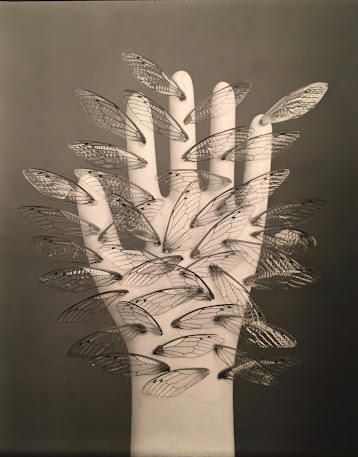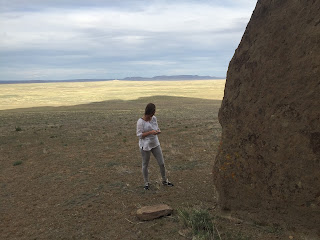Underfoot, Overhead, in my Hand and Ear.. Robert Langham III
Tyler, Texas.
Foot-walking. Angling down over the lip of the watershed. On red street bricks laid in the ‘20s. Under all this and all this and all this civilized neighborhoodly construct is the real landscape. About where I’m fitting my foot is a curving Caddoan creekside trail. Forgotten and buried. They followed the flow. The brick street is a straight line behind my should blade all the way through downtown. It crosses behind me to the North, a more robust segment of the Blackfork as it makes the circle North and West in a wide arc. Blackfork Creek. I’m nearly home. I am home.
Morning walk. Jupiter overhead and an arc of Venus (if you have 20X) rising. Saturn settling on the horizon behind West side trees. Shooting light, as a hunter would say. Enough so I’m looking at things instead of shapes and looms and rumors of houses and trees lurking in darkness.
In my pocket are fellow Blackforkians. Cicadas. Dead or languishing from under streetlights and on sidewalks. Being in my own country, I know where to look.
The dead will be laid out on table’s edge. The languishing will finish on the windowsill, view fading in those compound eyes made for flight. Safe from predation or parasites or dogs on leash with a taste for big insects. Everything eats them, jays to Copperheads. Or lays an egg in their remains. It’s a hatch and a feast. These in my pocket will pass in peace.
Cicadas are my favorite bug, so they were my daughter’s favorite bug. We caught them in the grass as they emerged, tracked them up tree trunks or rock walls. Watched them split their underground suits and do that weird hump & flip thing to hang untouched in air so their wings could pump out and dry. Then we would catch them, wear them like buttons or brooches. Her kindergarten class was terrified. She was very proud.
As a proud kid myself, I knew only the shed skins. They appeared as if by magic, clinging to wall, bark, and leaf. I carefully collected mason jars full and stood them along a shelf. When I was my daughters age I didn’t know the cycle or the secret of turquoise wings unfurling in the dark.
But finally, one begins to learn a little.
I liked them because they were natives, neighbors, indigenous. The landscape generated them and they cycled and cycled through time. Some are two years in the ground, some six, some eight, some fourteen, ect. So they say. I could never tell, though I asked. It was always the same old face, grilled and chitined. Big-eyed. Bug-eyed. Two weeks flying and singing and making love in the treetops while everything tried to eat them. Then into my pocket.
What don’t they do? Cascading as eggs from treetops. Underground nymphs in darkness sucking root sap. Digging out when some timer rolls over, climbing up and up to crack out and spend a couple of weeks flying and singing and mating in the sun. A good-sized bug. People sized. Singing that drowns out conversation. No stinger or bite. The green of deep pools and black lacquer. Wings like stained glass.
The first Cicada I remember seeing at Lindsey Lane was in the beak of a Blue Jay flying over my shoulder on the third floor. The Cicada was screaming. A thing I hadn’t considered. One evening Mortimer our cat darted in frantically, Cicada in mouth. The screaming was muted, but must have been unscrewing his brain from inside.
Just a few years back, when I thought I knew a bit about Cicadas, the City of Houston Parks Department got a complaint about Copperhead snakes congregating at night in Memorial Park. Calls were made and a herpetologist dispatched. He was astonished to find 50 or more Copperheads gathered around a few trees ...at midnight, eating Cicadas as they emerged from the ground. It must have been the best way to learn something new: In the dark, boot-deep in lethal serpents. Watching something inexplicable.
My work is taken out of the landscape, of things the landscape generates. So: Cicadas. I kept a ziplock bag of about 50 in the fridge that wife Katie saw every time she opened the door. Katie “got” me, tending to enjoy whatever tangent I wandered out on. That was only one of her superpowers. She was also good about questions.
“You’ve got a nice bag going there. How many do you think you need?” She asked. “I’m hoping to learn that exact number,” I replied.
“Do you know what you’re going to do with them?
“I’m waiting. It feels like something.”
“I counted, you know. Do you think you might have 60?”
“I bet 60. Or so.”
“You have 200. Plus. I gave up counting. It occurred to me they might not want to be counted.”
And so on.
When the photographic idea revealed itself it was all about the wings. The beautiful, paneled, church nave wings. The ideas flooded out of wherever ideas live and lined up in order, getting smarter as each scene was played. Wings on hands, in cups, slathered over juice glasses full of minnows, on faces. In tornadoes. They weren’t my ideas. They came from elsewhere popping into my head suddenly and without introduction. I’d learned to welcome them. I was the door. The guy with camera and film. I kept a cut-off plastic milk-jug bottom full of wings like a secret fortune. I could never have too many. Obsession. Long after the last cicada song note had faded into Winter and Spring I knew I’d run out.
I buried a lot of wingless Cicadas in the flowerbed. Slightly embarrassed about that.
On the red bricks. Gathering Cicadas. I know where to look and how. I see them across the street, down the block, on the sidewalk. A slight alarm is set for Copperheads. They must be a great delicacy. Birds chase them in intricate swoops and turns in mid-air. Dogs crunch them. They have a specialist predator: Sphecius speciosus. The Cicada Killer.
Sphecius is a large solitary digger wasp. “Large” as in bumblebee size. “Wasp” as in a yellowjacket or hornet on steroids. “Solitary” as in thank god. “Digger” as if the previous isn’t horrifying enough. As the hatch peaks they relentlessly hunt Cicadas, grappling them with all
the waspy mandibles and legs that come with flying insect predators, tumbling out of the treetops until they paralyze their prey with a species specific immobilizing sting. They frequently have to struggle their victim up something vertical (your pants leg will do) to dive off and get enough airspeed to fly with the weight and bulk of a live Cicada. The destination is a burrow freshly excavated. They get dragged below ground into familiar darkness. An egg is pasted on their abdomen. The egg hatches and the maggot begins to feed, devouring the living cicada carefully to preserve life until the last mouthfuls.
If left up to me, I’d rather stand in Copperheads in the dark. All the Cicadas wanted was to sing and mate in the Summer sunlight and heat.
Cicada Wasps require the living. I’m assembling the dead. On the sidewalk there is a fresh, expired, sung out and fucked out Cicada. With Fire Ants swarming.
The ants are cutting and drilling their way in by every seam and orifice. They don’t seem to be hauling cicada bits away, just butchering in. Maybe they are feeding on the spot.
Ants and pockets don’t mix. It leads to ants in pants, etc. So the carcass has to be chipped and flipped down the sidewalk, pausing just enough to let the ants unload and disperse. There are always more inside than out. I do rough counts: 11 off. 27 off. 17 off. 9 off. 15 out. Another 12. Finally I palm it up and walk, blowing ants away. 3 more. 7 more. 2 more. When they seem completely gone, there are another ten inside...hanging on. Make a note: There are always more Fire Ants. 200 in a freshly scoured carcass? 500?
A little righteous indignation about this. Fire Ants are a recently invasive species. Ecological disaster and displacer. How dare they! Occasionally it’s native ants, little blacks or sugar ants. Perhaps more than one species on a carcass. Exception being Fire Ants. They allow no other.
My friends. My kin. Survivors of their process. Finally falling to earth, out of time and energy. Languishing. An ant touches them with an antennae. Then more. A full assault follows. Eaten alive from inside out. The vinegar of ant pheromones filling interior voids. Sounds like horror. Perhaps it’s bliss. What would I know? The cranial system probably left until the end, the fat abdomen first on the menu.
If Cicadas are so obviously edible ...why don’t I eat them? I’m a flower photographer who chews petals. A landscaper who licks rocks. The Caddoans ate them. There are recipes online ...so so so ... But I have not. Yet. Cicada culinary cowardice I suppose. The leggy wingy-ness has thrown me. Exo-skeleton. Chitin. The freshly moulted are the best, no hardened armor and all the fat. Town bugs may contain insecticide and herbicides. 17 years of spraying the grass, of course. Going country is the best. Collect in paper sack and into freezer for 30 minutes, then stir fry with a bit of olive oil. Perhaps soon. Maybe my hesitation is because I love them too much already.
Finally, in front of my ancient camera, reversed and upside down, on my ground glass. out of my stash of wings and stack of props. Resolving some idea to image. How long was this manifestation underground, or treetop singing, or devoured by wasp maggot or invasive ant, until it came to me? Doesn’t matter. My job is to carefully fit feet to street down from the lip of the watershed and bring it home.















































































